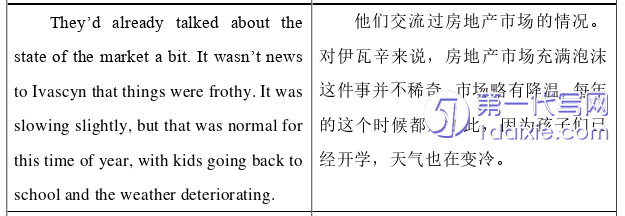本文是一篇英语论文,本报告通过应用关联理论中的最佳关联和假设等概念,始终从读者的背景知识与阅读感受出发,在必要时对原文的信息进行了转译与精简,使得译文兼顾了金融文本的专业性与译文的可读性,实践了关联理论对翻译的指导。
Chapter One Translation Process
1.1 Pre-translationAccording to relevance theory, the translator must first familiarize himself with the original text and have sufficient background knowledge to convey the original text (Gutt, 2006). To ensure a precise translation of a book about PIMCO and Bill Gross, a thorough research of the topic is indispensable.
The translator takes a comprehensive approach to become well-versed in PIMCO, its investment practices, and background. In addition, the translator devotes attention to Bill Gross and his background, education, career, investment philosophy, and accomplishments by researching various online resources such as financial news websites and watching video interviews featuring Bill Gross or Mary Childs.
In terms of choosing the right tools and references, the translator makes various preparations. This includes preparing dictionaries, such as the Oxford Collocations Dictionary, Collins Thesaurus, Merriam-Webster Dictionary, and Longman Dictionary, as well as utilizing online resources like Dictionary.com. Given the complexity of translating financial texts, the translator gathers some reference books, including Bill Gross on Investing: Everything You Need to Know about the Bond Market, and The Complete Guide to Investing in Bonds and Bond Funds. More importantly, the translator reviews the literature on relevance theory to grasp its key concepts and studies relevant translation cases to better apply the theory in this report.

1.2 Translation Process
Translating financial books, especially those that cover complex topics such as bonds and investment strategies may present several difficulties. The translator has encountered the following difficulties in the translation of The Bond King. Background knowledge poses one of the challenges when translating financial books for Chinese readers. Specialized terms in the source text may not have an equivalent in the target language. For example, the term “Wells Notice” does not have an equivalent in Chinese and needs to be translated into a short sentence instead of a noun. In such cases, the translator needs to use more descriptive language or flexible measures to better convey the meaning.
Also, China’s financial market practices differ significantly from those in the Western world. For instance, while certain bonds in the U.S. may be established and sophisticated, China’s popular bonds differ in nature. Specifically, while Treasury bonds are widely used and well-understood by investors in the U.S., Chinese investors are more familiar with corporate bonds or municipal bonds. Therefore, the translator should be aware of these differences and provide sufficient information through contexts.
Chapter Two Theoretical Framework
2.1 The Development of Relevance Theory in Translation
In 1975, Paul Grice introduced the principle of cooperation, which suggests that in the communication process, both parties to a conversation follow a certain principle, consciously or unconsciously, to work together effectively to accomplish the communicative task (Paul, 1975, pp.41-43). Sperber and Wilson proposed a framework for viewing communication from a cognitive perspective in 1987, building on Grice’s theory that communication is based on intentions and interpretations. They started with the premise that people pay attention to what they perceive to be most relevant in each situation (Malmkjaer, 2018, p. 96).
Ernst August Gutt’s doctoral thesis, Translation and Relevance: Cognition and Context, proposed a relevance theory of translation. Published in 1991, his work systematically explains this theory and its application to translation. Gutt was the first to integrate relevance theory into translation studies, pointing out that translation is a verbal communication behavior and a reasoning process closely related to the cognitive mechanism. Lin Kenan was the first to introduce the relevance theory of translation in the journal Chinese Translation to Chinese readers, outlining its theoretical principles and major concepts (Lin, 1994).
2.2 Key Concepts in Relevance Theory
Building on the principles of communication proposed by Grice, Sperber and Wilson developed a cognitive framework for understanding communication. This led to Gutt's integration of relevance theory into translation studies. Relevance theory includes several key concepts, such as cognitive environment, assumptions, and optimal relevance, which guide the translation process. Additionally, this theory offers guidelines on how to handle less common and complicated scenarios in translation.
2.2.1 Cognitive Environment and Assumptions
The cognitive environment of the target audience refers to both the knowledge and expectations of the readers who will be receiving the translated text (Ernst-August Gutt, 1991, p.44). It includes factors such as their background, culture, level of education, as well as their expected outcome from reading the content and the purpose of the text. Translation involves the communicative intent of the original author in creating the source text, as well as the desired response of the target audience. Translators act as intermediaries between cultures and must interpret the original text to make its meaning more accessible to the reader. They should navigate the complexities of languages to ensure that the translated text effectively conveys the intended message and achieves the desired response from the target audience.
Chapter Three Case Analysis ................................. 14
3.1 Word and Phrase Translation ......................... 14
3.1.1 Making Trade-Offs in Retaining the Relatively Important Meaning ................................. 14
3.1.2 Making Assumptions ..................... 17
Conclusion ........................... 31
Chapter Three Case Analysis
3.1 Word and Phrase Translation
This section analyzes how relevance theory is used by the translator in making trade-offs during translation and how to figure out the exact meaning of the original text by making assumptions.
3.1.1 Making Trade-Offs in Retaining the Relatively Important Meaning
This part includes cases in which the translator makes trade-offs in his translation. The translator retains the important meaning of the original text and omits minor ones, as they will cause the readers excessive efforts to grasp those information.
Case 1:
ST: To many within Pimco, especially the old guard, this was Pimco’s value proposition: it pushed clients a little outside their comfort zone, where there were more profits. Yet it rarely got into trouble with regulators—it had a multi-decade run with no pink slips from the teacher, no “Wells Notices” from the SEC, declaring impending action.
TT: 对于太平洋投资管理公司内部的许多人,尤其是老一辈人来说,这就是其价值主张:它把客户推到舒适区之外,以获取更多利润。然而,太平洋投资管理公司很少受到监管机构的调查——在长达数十年的时间里,公司没有收到过任何罚单,也没有收到过由美国证券交易委员会(SEC)发出的审查通知。

Conclusion
This report selects the first and eighth chapters of The Bond King, which describes the booms and bubbles of the U.S. real estate market before the financial crisis and covers Bill Gross's career from his early days as a whiz kid in the bond department of PIMCO to his departure from the company in 2014. It is one of the first works to reveal the important role bonds play in finance. Correspondingly, Financial English has its specific usage and readership, which requires the translator’s careful consideration.
This report takes relevance theory as its theoretical framework. This theory argues that the key to successful communication is to create sufficient contextual effects for readers without unnecessary effort to process the information. It is suggested by the theory to be aware of both the context of the source text and the cognitive environment of the readers in translation.
The translation practice in this report is reflected in the following aspects. Firstly, to provide the readers with sufficient contextual effect, a method that the translator frequently uses is to make the implied meaning explicit. Secondly, the translator bears in mind that a natural and smooth translation will not cost the reader unnecessary effort. To achieve this, the translator tries to conform to the habits of the target language and leaves out those overly culture-specific meanings. Thirdly, the translator makes full use of the concept and process proposed by relevance theories such as ostension-inference, making assumptions, and rearranges the source text to flexibly solve the problems encountered in practice.
reference(omitted)
